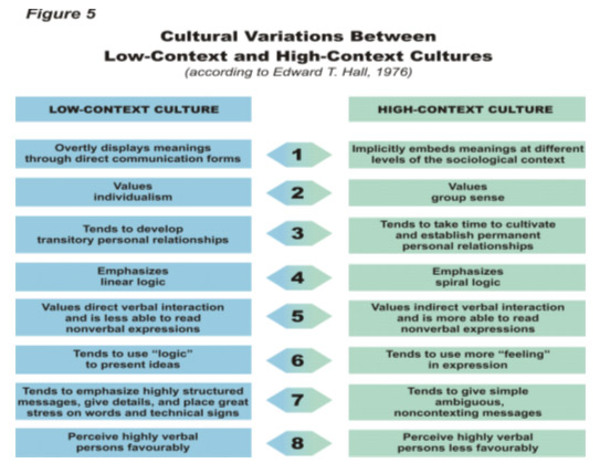2009-04-23[n年前へ]
■「高コンテキスト文化」と「低コンテキスト文化」の違い「箇条書き」 
 「高コンテキスト文化」と「低コンテキスト文化」が持つ典型的な特徴を並べたリストがなかなかに面白い。「高コンテキスト文化」と「低コンテキスト文化」の違い・特徴をリスト化したものは、派生したものがたくさん生まれている。たとえば、下に画像として貼り付けた箇条書きと、下に文章で箇条書きにしたものは、やはり少し違っている。
「高コンテキスト文化」と「低コンテキスト文化」が持つ典型的な特徴を並べたリストがなかなかに面白い。「高コンテキスト文化」と「低コンテキスト文化」の違い・特徴をリスト化したものは、派生したものがたくさん生まれている。たとえば、下に画像として貼り付けた箇条書きと、下に文章で箇条書きにしたものは、やはり少し違っている。

Low Context Communication
- Absolute values
- Need for precision in language - words carry explict meaning
- Responsibility based on contract
- Agreements written don and records kept
- Well-timed interruptions that move the conversation forward accepted
- Decision-making ideally logical
- Uncomfortable with silence(indicates a breakdown of communication)
High Context Communication
- Relative values
- Tolerance of verbal ambiguity(non-verbal and coded communication)
- Responsibility based on general agreement
- Written agreements flexible according to circumstances
- Interruptions considered rude, particularly when made by a junior
- Decision-making allowing for feelings
- Not uncomfortable with silence(can be communicative)
 こんな箇条書きを眺め、「(二つの文化の違いを整理した)各項目のどちらに対応するか」を確認することで、自分自身や自分の周囲の人、あるいは「集団」が、「高コンテキスト文化」と「低コンテキスト文化」のどちらのタイプに属するか、あるいはどちらの傾向が強いか、を比較・自覚してみると面白いと思う。そうすることで、コミュニケーションの中で起こる問題が「あぁ、なるほど。これは必然的に起こることなんだな」と理解できたり、その対策をとることができたりもするかもしれない。
こんな箇条書きを眺め、「(二つの文化の違いを整理した)各項目のどちらに対応するか」を確認することで、自分自身や自分の周囲の人、あるいは「集団」が、「高コンテキスト文化」と「低コンテキスト文化」のどちらのタイプに属するか、あるいはどちらの傾向が強いか、を比較・自覚してみると面白いと思う。そうすることで、コミュニケーションの中で起こる問題が「あぁ、なるほど。これは必然的に起こることなんだな」と理解できたり、その対策をとることができたりもするかもしれない。
■Powered
by yagm.net
